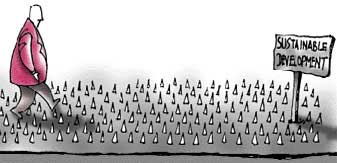Looking ahead
 EVERYBODY wants growth and development. Yet, there is a serious cost attached to it. The point is what kind of growth is both desirable and sustainable. Resources of all types constitute our capital for growth. But, for growth to be made meaningful and enduring, the capital base has to be widened and returns increased as well as made sustainable. If returns on resources are prudently improved the quality of life can be made better for all through appropriate policy and action.
EVERYBODY wants growth and development. Yet, there is a serious cost attached to it. The point is what kind of growth is both desirable and sustainable. Resources of all types constitute our capital for growth. But, for growth to be made meaningful and enduring, the capital base has to be widened and returns increased as well as made sustainable. If returns on resources are prudently improved the quality of life can be made better for all through appropriate policy and action.
Let us briefly take the case of India. Since independence, we have made substantial progress in many spheres of development. But the benefits of growth have been considerably off-set by environmental degradation. There have, of course, been many positive gains. We have, for example, achieved food security. Yet, this has been achieved by adopting input-intensive agriculture. In doing so several negatives have emerged in the shape of degraded soils, lowering of water tables, poor water management and adverse impacts that have accompanied the accelerating use of pesticides and inorganic fertilisers. Similarly, industrial growth, urbanisation and the inexorable demographic pressures have generated more and more of pesticides and inorganic fertilisers. They have also generated more and more of wastes that pollute our air, water and land.
Nearly 175 million hectares of land (about 58 per cent) suffers from one or the other type of degradation. The availability of renewable fresh water per capita, which was about 6,000 cubic metre (cum) in 1947, has come down to about 2,200 cum in 1999. We are heading towards becoming a 'water-stressed' country. Apart from quantitative dimensions, the quality of water leaves much to be desired. Each year we lose more than six billion tonnes of soil due to erosion. Water and wind erosion have been aggravated by deforestation, overgrazing and agriculture on steep slopes and other vulnerable areas. Salinity and waterlogging are other serious problems we face.
Many factors of degradation are human-made, such as the absence of drainage in the canal systems. Our effective forest cover, which ought to be one-third of the total geographical area, is only about one-eighth. The need for enhancing the permanent vegetal cover and its quality has become critical as never before. There is widespread air pollution. We are told that in about 20 cities, air pollution is 'dangerous', and in 14 it is 'bad'. Air pollution has increased because of industrial growth, fast urbanisation, setting up of giant thermal power plants and the rapidly increasing number of four- and two-wheeled automobiles, the number of which has gone up to nearly 50 million.
The causes of air pollution are, among others, poor technology and bad traffic management. Air pollution is not only an urban problem. It affects rural areas as well. According to the Tata Energy Research Institute, about 2.5 million premature deaths were caused by air pollution in 1997. Water pollution is another serious problem. Sewage generation in the country has gone up six times since 1947. The annual municipal solid waste has increased from eight times in the same period.
How do we make development sustainable in India? Experts tell us that the average rate of growth in the next five decades will exceed six per cent. If unchecked, the population will be nearly 1,750 million around the middle of the 21st century. More than half of this will live in urban areas. We have to adopt methods of production where renewability is a definite factor of preference. We need to treat and recycle wastewater for re-use, adopt conjunctive use of surface and groundwater and put in place appropriate pricing policies that discourage waste.
Our additional food requirements will have to come largely from diversification and productivity gains. We need to restore and retrieve degraded, alkaline and waterlogged areas. The forest cover has to go up. For doing so alternate fuels and energy resources will have to be developed and conservation stressed. There will have to be clear emphasis on public transportation. To the extent possible, wastes will have to be recycled and converted into wealth. We already have or can develop or obtain the technologies through the adoption of which vast improvements can be brought about in both resource mobilisation and resource utilisation in a sustainable manner.
Thus, improved quality of life can be achieved for more and more people in the country. In short, the strategy has to be to enhance our resource bases on the one hand and improve annual returns from these in expanding and sustainable ways. The other important requirement is to bring about within the country equity in the rightful use and enjoyment of resources so that all citizens can share in the prosperity of the nation. We need eco-literacy for all. We need geo-piety for survival.
Related Content
- Energy security and the green transition
- World energy transitions outlook 2023: 1.5°C pathway, Volume 2
- State of working India 2023: social identities and labour market outcomes
- Climate change, vulnerability and security in the Sahel: three scenarios for Burkina Faso, Mali and Niger in 2050
- Order of the Supreme Court of India regarding grant of forest clearance for the Delhi-Dehradun expressway, 19/04/2022
- Reimagining the future of transport across Asia and the Pacific
